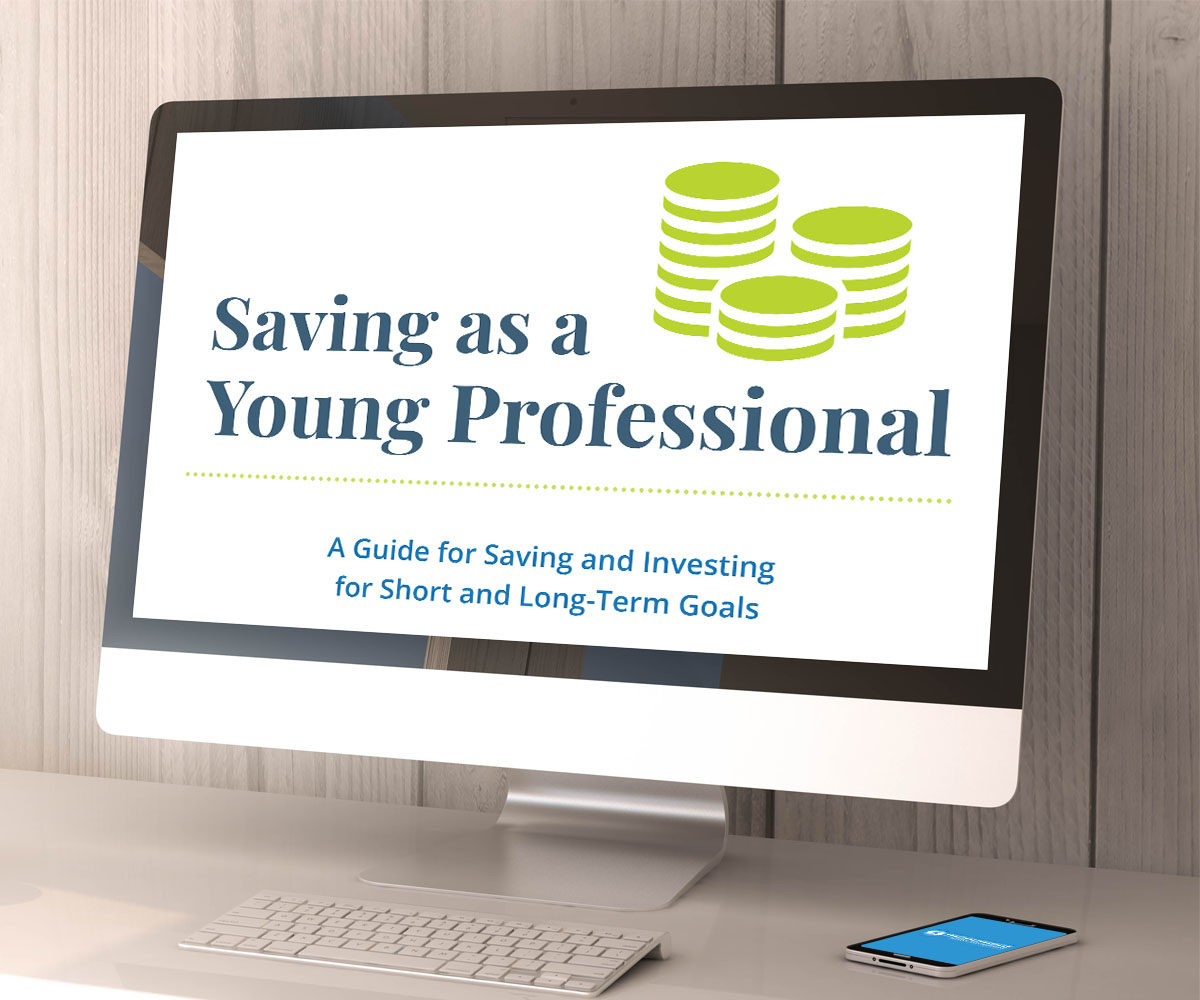Monument Wealth Management Articles
Saving As a Young Professional

Share on your favorite platform, or by email
Saving as a Young Professional
A Guide for Saving and Investing for Short and Long-Term Goals
Saving and Investing for Short and Long-Term Goals
When you are a young professional and retirement seems far away, prioritizing how much and where to save can be a challenge. Below are a few savings guidelines to keep in mind:
You should strive to have at least 3-6 months of living expenses available to cover any short-term emergencies that arise.
- Your emergency fund could be a savings account or a money market account – something that is liquid and stable. It is best not to view your investment accounts as emergency funds due to the fluctuations that can occur in the market – these accounts are appropriate for longer-term goals.
- If you don’t already have an emergency fund in place with an amount that you feel comfortable with, using any excess cash flow to build this up should be your top priority.
The earlier you begin saving for long-term goals, like retirement or a future large expenditure, the more time you have to enjoy the benefits of compounding interest. Someone who begins saving in their twenties or early thirties will not need to save as much of their annual income for future goals as someone who begins in their forties or fifties.
- The recommended amount of your annual income to save in your as a young professional to work toward a comfortable retirement is 15-20%.
- The 15-20% can be a combination of personal contributions to retirement accounts, employer matches to retirement accounts, or money invested in a personal investment account.
When determining the amount to save for retirement, you should also consider shorter-term goals. While 15% is the suggested amount to save for retirement, this may not be possible if there are other short term goals to save for.
- If you can’t devote 15% to retirement savings, make sure you contribute at least enough to an employer plan to get the match if available or take advantage of the maximum contribution to an IRA or Roth IRA if you don’t have an employer plan.
- Retirement-specific vehicles will provide tax-deferred growth on your earnings that will increase the impacts of compounding interest over the long-term
- Prioritizing your goals can help prioritize your order of savings.
- If you are comfortably contributing 15% or the maximum amount to retirement vehicles and would like to invest money for other goals (home purchase, large future expenditures) consider the amount of time until you need to access the funds – this will help inform your decision on how to invest the money (aggressive growth, a more balanced approach, capital preservation, etc.).
EMERGENCY SAVINGS
3-6 Months of Expenses
RETIREMENT ACCOUNTS
Employer-sponsored
retirement account
with match, IRAs
15-20% if possible
PERSONAL INVESTMENT ACCOUNTS
Allocation and amounts dependent on short & long-term goals
Benchmark Amounts for Investment Assets by Age
The table below illustrates how much of your gross pay you should have saved across all investment accounts (Employer-sponsored retirement plans, IRAs, investment accounts) by certain ages to have a comfortable retirement in the future. Young professionals today will be even more reliant on their personal savings than prior generations, who were entitled to pensions at retirement and had less reliance on personal savings.
| Age | Investment Assets v. Gross Pay Ratio Needed at Varying Ages |
| 25 | 0.20 : 1 |
| 30 | 0.6-0.8 : 1 |
| 35 | 1.6-1.8 : 1 |
| 45 | 3-4 : 1 |
| 55 | 8-10 : 1 |
| 65 | 16 – 20 : 1 |
For example, if you are 35 with gross annual income of $100,000, it is recommended that you have $170,000 invested for your retirement (100,000 x 1.7). The amounts above illustrate the power of compounding interest over time. They represent benchmarks to work toward, but they are by no means personalized recommendations. Depending on your lifestyle goals and individual needs, your portfolio requirements may be different.
Types of Retirement Accounts
Tax-deferred vehicles for retirement savings can be powerful – the money you contribute goes directly from your paycheck into your retirement account without being taxed. All earnings on your investments will compound over time with no taxes paid until you withdraw the funds in retirement. This allows the power of compounding to work favorably for savers with a long time horizon. Retirement vehicles should be maximized as part of your annual savings plan.
Employer-Sponsored Retirement Plans
These are sometimes known as 401ks, 403bs, or profit sharing plans. There are many names but the thing that they have in common is that they are all sponsored by an employer – you can’t just open an account on your own and enjoy the high contribution limits.
- Employees in qualified plans can contribute up to $19,500 annually in 2021 pre-tax.
- Their employer may make matching contributions or discretionary contributions as part of their benefits package.
- These accounts can receive up to $56,000 in 2021 from employee and employer contributions.
- If you have a plan available – contribute at least enough of your salary to take advantage of your employer match.
Self-Employed Retirement Accounts
If you don’t have the benefit of a qualified plan through an employer because you ARE your employer, there are still tax-advantaged ways to save for retirement.
- A Simplified Employee Pension (SEP IRA) may be a good fit if you are looking to save an amount above the personal IRA limits. (more on that below)
- Self-employed individuals can make a tax-deductible contribution in the amount of the lesser of: 25% of compensation or $56,000 in 2021.
- These plans are very simple to set up and you still remain eligible to contribute to personal IRAs if you want to maximize tax-deferred accounts.
- Earnings on your investments grow tax-deferred – they are taxed in the future when you withdraw them, along with your pre-tax contributions.
- SEP IRAs can help a self-employed individual realize significant tax savings by reducing current taxable income.
IRAs (Individual Retirement Arrangements)
These are accounts that individuals can open separate from employer sponsored accounts to enjoy similar tax benefits for their retirement
savings.
- They come with much lower contribution limits than employer plans, along with qualification limitations.
- There are two kinds of IRAs available: Traditional and Roth. We recommend maximizing a Roth IRA if you are able to.
- It is important to note that the $6,000 contribution limit is across ALL IRAs. You can only contribute $6,000 total – not $6,000 to a Roth and $6,000 to a Traditional IRA.
| TRADITIONAL | ROTH | |
| CONTRIBUTION LIMIT | $6,000/year | $6,000/year |
| TAX FEATURES | • Contributions may be deductible
• Earnings grow tax-deferred until you withdraw money in the future • Withdrawals at retirement (Age 59 ½ or later) are taxable as ordinary income |
• Contributions are made with after-tax dollars (no deduction)
• Earnings grow tax-deferred • Withdrawal of contributions and earnings are tax-free after Age 59 ½ (if you’ve had a Roth IRA for at least 5 years) |
| LIMITATIONS | • Anyone can contribute if they have earned income, but the ability to deduct the contribution (make it pre-tax) depends on income and participation status in an employer plan | • Ability to contribute the maximum amount may be reduced or fully eliminated for people in the following Modified Adjusted Gross Income ranges:
Single: $125,000 – $140,000 Married: $198,000 – $208,000 |
Security isn’t being able to predict the future; it’s about knowing you have a solid plan in place. That’s why it’s important to sit down with an Advisor who knows how to listen, and can help explain your options, all of them, so you can understand why it’s worth considering one over another.
About Monument Wealth Management
Our Team specializes in working with people that have come into sudden newfound wealth, such as from the sale of a sizable business or a large inheritance. They are faced with a need for meaningful advice, clarity, and conviction that they simply cannot get from the typical advisor at a large Wall Street firm. They are looking for a true Team, one made up of several freethinking, opinionated experts from different disciplines, or as we refer to it, a Collective Mastermind. That’s where we step in.

Saving as a Young Professional
Ready for straightforward, unfiltered opinion and tailored advice for YOUR questions, not everyone else’s?
IMPORTANT DISCLOSURE INFORMATION
Please remember that past performance is no guarantee of future results. Different types of investments involve varying degrees of risk, and there can be no assurance that the future performance of any specific investment, investment strategy, or product (including the investments and/or investment strategies recommended or undertaken by Monument Capital Management, LLC [“Monument”]), or any non-investment related content, made reference to directly or indirectly in this blog will be profitable, equal any corresponding indicated historical performance level(s), be suitable for your portfolio or individual situation, or prove successful. Due to various factors, including changing market conditions and/or applicable laws, the content may no longer be reflective of current opinions or positions. Moreover, you should not assume that any discussion or information contained in this blog serves as the receipt of, or as a substitute for, personalized investment advice from Monument. To the extent that a reader has any questions regarding the applicability of any specific issue discussed above to his/her individual situation, he/she is encouraged to consult with the professional advisor of his/her choosing. No amount of prior experience or success should be construed that a certain level of results or satisfaction will be achieved if Monument is engaged, or continues to be engaged, to provide investment advisory services. Monument is neither a law firm nor a certified public accounting firm and no portion of the blog content should be construed as legal or accounting advice.
A copy of Monument’s current written disclosure Brochure discussing our advisory services and fees is available for review upon request or at www.monumentwealthmanagement.com/disclosures. Please Note: Monument does not make any representations or warranties as to the accuracy, timeliness, suitability, completeness, or relevance of any information prepared by any unaffiliated third party, whether linked to Monument’s website or blog or incorporated herein, and takes no responsibility for any such content. All such information is provided solely for convenience purposes only and all users thereof should be guided accordingly.
Historical performance results for investment indices, benchmarks, and/or categories have been provided for general informational/comparison purposes only, and generally do not reflect the deduction of transaction and/or custodial charges, the deduction of an investment management fee, nor the impact of taxes, the incurrence of which would have the effect of decreasing historical performance results. It should not be assumed that your Monument account holdings correspond directly to any comparative indices or categories. Please Also Note: (1) performance results do not reflect the impact of taxes; (2) comparative benchmarks/indices may be more or less volatile than your Monument accounts; and, (3) a description of each comparative benchmark/index is available upon request.
Please Remember: If you are a Monument client, please contact Monument, in writing, if there are any changes in your personal/financial situation or investment objectives for the purpose of reviewing/evaluating/revising our previous recommendations and/or services, or if you would like to impose, add, or to modify any reasonable restrictions to our investment advisory services. Unless, and until, you notify us, in writing, to the contrary, we shall continue to provide services as we do currently. Please Also Remember to advise us if you have not been receiving account statements (at least quarterly) from the account custodian.
